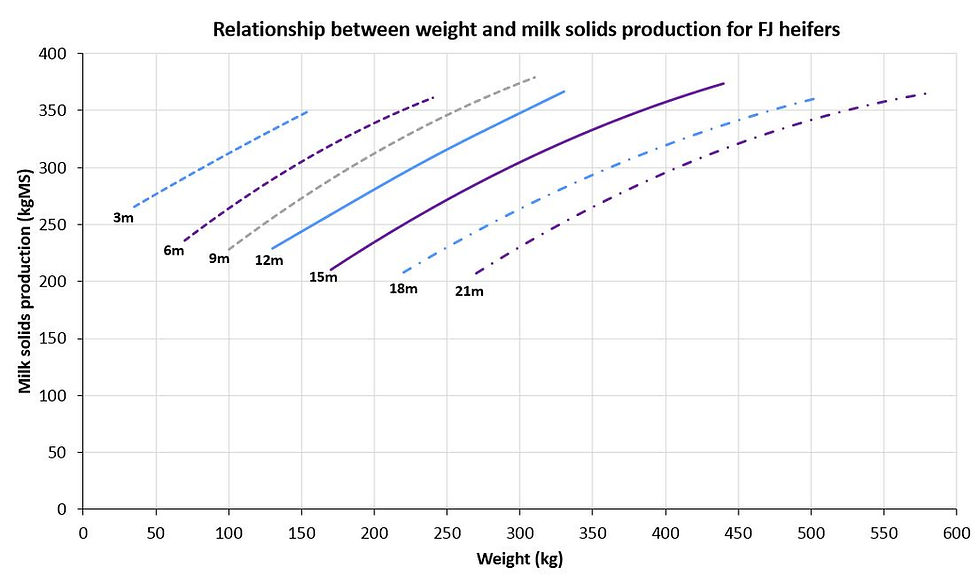Studies from New Zealand and elsewhere have reported that there are positive relationships between live weights and milk production in dairy heifers.
Interestingly, these studies either classified heifers as "heavier" or "lighter" and compared them OR they only looked to see if the relationship between weight and milk was linear.
This means they assumed a 1kg increase in weight of a light heifer would have the same milk production response as a 1kg increase of a heavy heifer.
As one of my PhD supervisors often says - biology tells us that there is likely to be a "maximum" where further increases in weight would not invoke an increase in milk production.
In other words, a 1kg increase in an already heavy heifer may not result in more milk...
If you missed it.. you can check out Part 1 here - "NZ Dairy Heifers: snapshot of weight and milk production"
Key Points
An increase in weight was always associated with an increase in first-lactation milksolids production for all 5 breed groups, for most ages studied.
Lighter heifers responded better to an increase in weight compared with heavier heifers.
Potentially, we should consider preferentially feeding lighter heifers to attain heavier weight in order to improve milk production.

Also of interest is that there are not many studies that separate out the breeds and look at the relationships between weight and milk for each breed separately. As we summarised in Part 1 of this post, there are differences in weight and milk production among common dairy breeds and crosses in NZ.
As mentioned before, heifers were split into 5 breed groups;
Holstein-Friesian (F)
Holstein-Friesian crossbred (FX)
Holstein-Friesian-Jersey crossbred (FJ)
Jersey crossbred (JX)
Jersey (J)
The descriptions of the 5 breed groups as well as their average weights and milk production is given in more detail in Part 1 of this post.
Weights of the heifers were known and used to study the relationship between weight and milk production.
Ages studied were 3, 6, 9, 12, 15, 18 and 21 months of age within each breed group. What this means is that the effect of an increase in weight was considered separately for each breed group and each age.
This helps to answer the question of: "What is the effect of increasing weight for each breed at each age?"
First lactation milk production
An increase in weight was always associated with an increase in first-lactation milk solids (milk fat plus milk protein) production for all 5 breed groups for most ages studied.
To make it a bit easier to interpret, below are the results for FJ heifers only. If we look across the bottom of the graph (or x-axis) we have heifer weight and on the left side of the graph (or y-axis) we have milk solids production.
If we take the 3 month line first we can see that if a heifer was heavier (further right along the dashed blue line) she produced more milksolids in her first lactation than if she were lighter (further left along the dashed blue line).
We can repeat this for each age from 3 to 21 months and it clearly shows that for each age, an increase in weight was associated with an increase in milk production.

Generally, for the other breed groups (FX, JX and J), the relationship between weight and milk production was very similar to what is shown for FJ heifers in Figure 1 above.
For F heifers however, there was no relationship observed between weight and milk yield at 3 months of age. This means that as F heifers were heavier at 3 months of age, this did not correlate with an increase in first lactation milk production.
For all the other ages (6, 9, 12, 15, 18 and 21 months), a positive relationship between weight and milk production existed i.e. being heavier at these ages was associated with F heifers producing more milksolids.
Lets take a closer look at some examples...
The average weight of FJ heifers was approximately 300kg at 15 months of age, and 420kg at 21 months of age (See Part 1).
Heifers that were 20kg lighter than average (280kg) produced 12kg less milksolids than the average 15-month-old FJ heifer (Figure 2).
Heifers that were 20kg heavier than average (320kg) at 15 months of age, produced 12kg more milksolids than the average 15-month-old FJ heifer (Figure 2).

Similar relationships existed for 21-month-old FJ heifers (Figure 2) and for heifers of the other breed groups.
These results show the potential to increase first-lactation milk production of New Zealand dairy heifers by increasing heifer weight - especially focusing on the lightest heifers.
Interestingly, within the age and weight range available for the study, there was no 'maximum' weight at which a further increase in weight resulted in no change or a reduction in first lactation milk production.
But what about other lactations?
What about later lactations? Do the high producing heifers 'burn out' after a few years?
Ideally, we would have had 'lifetime milk yields' which defined as the total milk production from their first calving up until they exited the herd.
Unfortunately, we didn't have that information for all heifers. We settled for an in-between measure: 'Accumulated three-year production'.
This is the total milk production for 3 years (or dairy seasons) from their first calving. Or in other words their 'lifetime' yield up until the end of their 3rd lactation - read Part 1 for a more thorough explanation.
Similar to first-lactation production, the heifers that were heavier produced more accumulated milk solids compared with the heifers that were lighter.
And to tie it all together, below in Figure 3 are the results for FJ heifers, for all 7 ages studied. As before, we have heifer weight across the x-axis (bottom) and milksolids production up the y-axis (side), just this time it is the accumulated production and not the first lactation production.
It clearly shows that for each age, an increase in weight was associated with an increase in milk production - to a point...

The arrows on the graph point to where the 'maximum' weight occurred. Which means that being heavier than this weight did not result in an increase in milk production. As can be clearly seen by the graph, these 'maximum' points are at the very heaviest end of the weight range for each age group.
Additionally, for the most part, an increase in weight did not result in a decrease in milk production, just no further increase.
For example, the average weight of 6-month-old FJ heifers was 150 kg. The weight at which the maximum accumulated milk was predicted (where the arrow is) was at 227 kg. A whopping 77 kg heavier than the average for that breed group and only 11 kg lighter than the heaviest record in the dataset for FJ heifers at 6 months of age.
Similarly, the average weight of 21-month-old FJ heifers was approximately 420 kg. The weight at which the maximum accumulated milk was predicted was at 523 kg - 103 kg heavier than the average!!
If you are enjoying this post, you may like one of these:
Interestingly, although the statistical analysis showed that the relationship between 12-month weight and milk production was curvilinear, it looks like a much straighter line than some of the other ages.
One potential reason for this is that at 12 months of age (winter), the chances of being very well fed and heavy are much lower, due to feed availability compared to say 15 months of age (spring flush). Had there been more 'super heavy heifers' at 12 months of age, we may have seen the graph begin to taper off.
If we compared heifers as we did for first lactation, the average weight of FJ heifers was approximately 240kg at 12 months of age (Part 1).
Heifers that were 20kg lighter than average (220kg) produced 46kg less accumulated milksolids than the average 12-month-old FJ heifer (Figure 4).

Heifers that were 20kg heavier than average (260kg) at 12 months of age, produced 40kg more accumulated milksolids than the average 12-month-old FJ heifer (Figure 4).
Again, similar relationships existed for 21-month-old FJ heifers (Figure 4), those that were average in weight (420kg) produced 34kg more accumulated milksolids than those that were 20kg lighter than average.
For heifers of the other breed groups, these relationships were again very similar.
What does this all mean?
Importantly, the results show that for most ages, an increase in weight for a light heifer had more of an impact on milk production than an increase in weight of a heavy heifer.
For NZ dairy heifers that were of average and below average weight (for their breed group), we can expect considerable milk production benefits over the first 3 lactations by improving rearing practices to result in heavier heifers in the 2-year period before first calving.
This leads us to believe that for the majority of heifers in NZ, being 'too heavy' is unlikely to be an issue, whereas, being 'too light' is of much greater concern.
Whether we can achieve this by preferentially feeding the lightest heifers or by increasing the feed provided to all heifers is one question this study could not answer.
Additionally, more research on the relationships between weight and survival of heifers is required (COMING SOON!) to confirm whether the heavier heifers survived longer than the lighter heifers.
If this is indeed true, it would help to explain why the relationship between weight and accumulated yields was more curvilinear (not a straight line; Figure 3) than the relationship between weight and first lactation milk production (Figure 1).
I will leave you with my favourite saying from my 5.5 years of studying NZ dairy heifers...
"Bigger, bigger, bigger!"
What did you think about this week's post? After reading it is there anything you would consider doing differently on farm? Let us know your thoughts on our Facebook page (www.facebook.com/agrisciencer) or in the comments below.










Kommentare